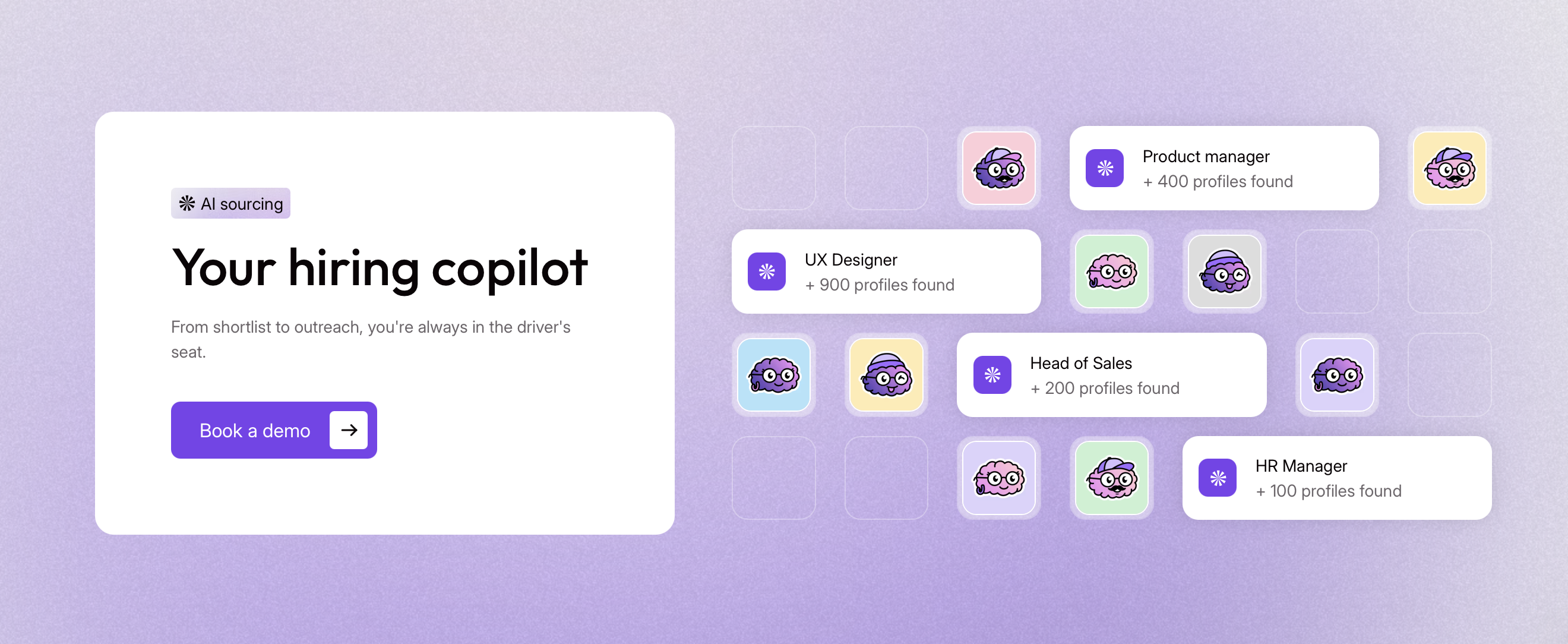How Do You Find and Recruit Passive Candidates in 2025? (The Best Talent)
Candidate relationship management in 2025 requires recruiters to move beyond job postings and Easy Apply. The best talent often comes from passive candidates, who need personalized, well-timed outreach across multiple channels. Kalent helps streamline this process with AI-driven tools that identify passive candidates, personalize communication, and track long-term relationships, making recruitment more effective and less time-consuming.
How to Handle Candidate Relationship Management in 2025
Candidate relationship management is especially challenging in 2025. Today, the top talent is unlikely to be the ones clicking Easy Apply on LinkedIn – instead, they could be happy in their jobs and not actively job hunting unless the right opportunity comes around. So how are you supposed to find them?
Modern recruiters need to completely change how they manage candidate relationships. Instead of posting a job and waiting for applications, successful recruiters need to build clear, targeted strategies to help them find candidates they might otherwise miss.
In this article, we’ll share our tips for great candidate relationship management, as well as the challenges of trying to recruit passive candidates.
How Has “Easy Apply” Impacted Recruitment?
LinkedIn’s Easy Apply feature might have seemed like a great innovation when it first appeared, but it can make both candidate relationship management extremely difficult and time-consuming.
With just one click, now any candidate can reply to multiple job posts quickly and without divulging much personal or career-specific information, leaving recruiters and hiring managers absolutely flooded with applications.
Of course, many of these applicants will be well qualified for the job but are unable to put their best foot forward due to the limitations of the Easy Apply feature. Others will be completely wrong for the role or won’t have any of the relevant expertise or background experience.

The result is that most recruiters spend their time sifting through irrelevant applications instead of finding great candidates for their candidates. This can negatively impact candidate relationship management and lead to poorly aligned relationships. It also means the people you actually want to hire slip through the net.
Many of these “gold standard” hires would be classified as “passive candidates,” meaning they’re not actively looking for a new role. They will be harder to find and even more difficult to engage because they don’t have that Open to Work banner on their profile and they’re not trawling through job boards.
Why Is Recruiting Passive Candidates So Challenging?
If you want to practice better candidate relationship management, you need to be targeting passive candidates as well as active ones.
Passive candidates aren’t posting their resumes online or browsing LinkedIn for new jobs. Mainly, they’re working at other companies in high-level jobs, focused on their current role and responsibilities. To engage them, you’ll need specialized tools and strategies (as well as great communication).
These kinds of passive candidates are most common in C-suite executive roles, as well as in highly competitive fields like tech, engineering and software development. Once you find them, reaching out can be difficult. Most passive candidates field dozens of messages on LinkedIn every day, and you risk being dismissed as just another pushy recruiter.
Your messaging is important, but timing also plays a key role. Even if your candidate is potentially interested in a new opportunity, they may not be ready to move right now. Some senior jobs also have notice periods of three months or more. Successful recruiters understand they need to foster genuine relationships with these passive candidates and stay connected over months or even years until the right timing aligns.
Candidate Relationship Management: Top Tips from Kalent
Managing candidate relationships in 2025 requires a completely different approach from what recruiters were doing five years ago. When you add passive candidates into the mix, it can be even more difficult.
Based on Kalent’s experience of helping recruiters improve their reply rates from 10% to 30-60% and higher, here are some tips.
Prioritize Context in Your Outreach Messages
One of the biggest mistakes a recruiter can make is sending generic outreach messages to candidates. If a message is vague, non-specific and not personalized, no one is going to read it.
The secret to successfully managing candidate relationships is to show people that you actually care about who they are and why the specific role might appeal to them – not just listing the job requirements and asking if they’re interested. Mention their specific skills and experience to show you “get” them, and they’re much more likely to respond positively.
Use Multiple Channels to Connect
LinkedIn is a great first step, but it’s not the only channel you should be using – you could be missing out on great candidates who never use the platform.
Email works well for professional communications and people in senior roles, so don’t be afraid to contact them directly if their email address is readily available. This shows that you’re serious and allows you to explain the role properly without character limits.
Location is important too. In the U.S., candidates are known to communicate with recruiters over iMessage and SMS, whereas in Europe, WhatsApp is a familiar form of communication.
A multi-channel approach is also helpful if you haven't heard back from a candidate and you want to follow up. This gives you a better chance of getting a response without feeling like you’re being pushy.

Avoid Spammy, Templated Messages
A major rule of effective candidate relationship management is to avoid spammy or overly templated messages. Some recruiters send out mass emails that don’t even include the candidates' names and wonder why they don’t get a response!
Reaching out to passive candidates won’t damage your reputation, as long as it’s done right. There is a huge difference between spam and effective outreach – spam is overly generic, unprofessional and sent to everyone, whereas good outreach is personalized, relevant and targeted.
If you get this right, you’ll find you can form relationships even with candidates who aren’t interested, and you never know when their situation might change. Your goal isn’t to pressure anyone into responding but to find those people who might be genuinely open to new opportunities – now or in the future – that align with the roles you’re trying to fill.
How Kalent Helps Streamline Candidate Relationship Management
Candidate relationship management can be difficult, complex and time-consuming. Kalent helps you identify passive candidates by searching beyond traditional job boards and databases, using specific criteria instead of just basic keywords.
Our AI can also help you craft personalized outreach messages by combining all the details of your job posting with the candidate’s experience and background information. You’ll get suggested message templates that you can tailor to each specific candidate and role to help you generate more meaningful, authentic connections with top talent.

Kalent also tracks your interactions and relationship history, making it easy for you to foster professional relationships over time, picking up each time where you left off.
You’ll also save time and money using Kalent’s platform, freeing you up to do more of what you do best – building genuine relationships with candidates and guiding them through the hiring process. We’ll take care of the admin and research!
Book a demo today and we’ll show you exactly how it works, or find out more about our tools and features.





